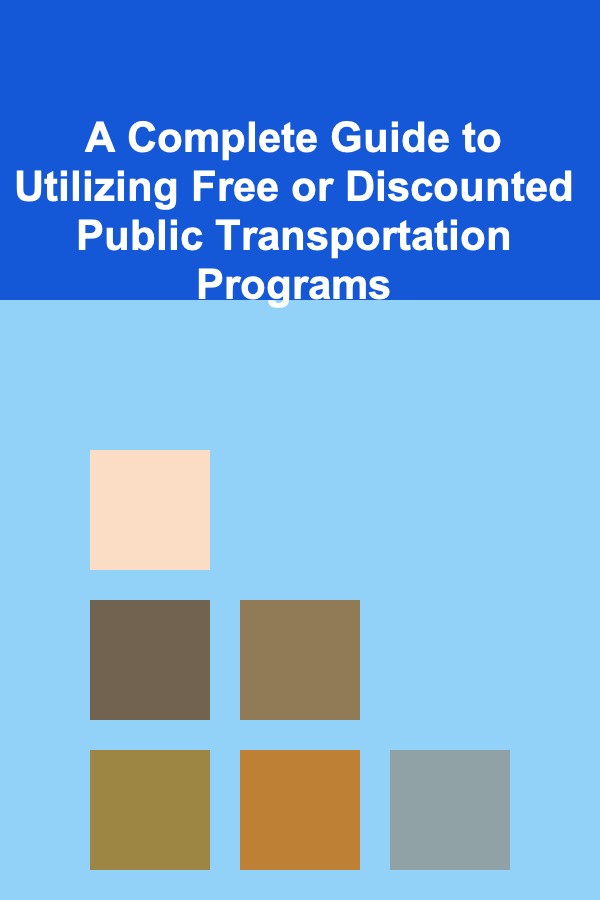
A Complete Guide to Utilizing Free or Discounted Public Transportation Programs
ebook include PDF & Audio bundle (Micro Guide)
$12.99$6.99
Limited Time Offer! Order within the next:

Public transportation is an essential part of daily life for many people, offering a cost-effective and eco-friendly alternative to owning a car. However, the costs associated with using public transport can add up, especially in larger cities where transportation fees are high. Thankfully, there are various programs, discounts, and even entirely free public transportation services available for individuals who qualify. These programs aim to make transportation more accessible, reduce financial burdens, and encourage sustainable practices.
In this actionable guide, we will walk through how to find and take advantage of free or discounted public transportation programs. Whether you're a student, senior, low-income individual, or someone with a disability, there may be options available to help you save money and make commuting more affordable.
Understanding the Types of Public Transportation Discounts
Before diving into specific programs, it's important to understand the general types of discounts or free services that are commonly offered by public transportation authorities:
a) Student Discounts
Many cities and transportation networks offer discounted fare programs for students. These discounts can range from a flat percentage off the regular fare to unlimited monthly passes at a reduced price. These programs are designed to make commuting to school or university more affordable.
b) Senior Citizen Discounts
Seniors often qualify for discounted or even free public transportation. The eligibility criteria may vary, but typically, individuals over the age of 65 can access special programs that allow them to travel at lower rates or for no charge at all.
c) Low-Income Assistance Programs
Public transportation authorities often have reduced fare programs for low-income individuals or families. These programs are designed to help those who have limited financial resources access transportation services. Low-income assistance programs are typically based on income eligibility requirements and may offer a fixed discount or subsidized fare rates.
d) Disability Discounts
For individuals with disabilities, many public transit systems offer discounted or free fares. These programs are intended to make transportation more accessible for those with mobility challenges or other disabilities.
e) Commuter Benefits and Employer-Sponsored Programs
Some employers offer transportation benefits, such as subsidized transit passes, tax-free commuter benefits, or pre-tax deductions for transportation expenses. These programs can significantly reduce the cost of commuting to work, making it more affordable for employees to use public transit.
f) Free Transit Services
Certain cities and municipalities offer entirely free public transportation options. These services are typically available in smaller areas or districts and are designed to reduce traffic congestion, promote sustainability, or make essential services more accessible to residents.
Identifying Available Free or Discounted Programs in Your Area
The first step in utilizing free or discounted public transportation programs is identifying what's available in your specific area. Different cities, states, or regions have different programs in place, and eligibility criteria can vary greatly.
a) Check with Your Local Transit Authority
Every city or region typically has a local transit authority responsible for operating public transportation services. These authorities will provide information on any discount programs or free services they offer. You can usually find this information on their website, social media accounts, or by directly calling or visiting their offices.
b) Look for City or Regional-Wide Programs
Some cities have broader programs that apply to all forms of public transportation. For example, New York City's MTA offers a reduced fare program for seniors and people with disabilities, while San Francisco's Muni offers discounted fares for low-income individuals. Some municipalities also have free shuttle services or transit systems within certain neighborhoods.
c) Eligibility Requirements
When reviewing programs, check the eligibility requirements. Most public transportation discount programs have specific criteria that must be met in order to qualify. For example, low-income programs might require proof of income, while senior citizen discounts typically require identification showing age.
How to Apply for Public Transportation Discounts or Free Programs
Once you've identified the available programs in your area, you will need to apply for the ones you are eligible for. Here's how to get started:
a) Gather the Necessary Documentation
For most programs, you'll need to provide certain documents to prove your eligibility. Common documentation might include:
- Proof of income (for low-income discounts)
- Age verification (for senior citizen discounts)
- Disability documentation (for disability-related programs)
- Enrollment verification (for student discounts)
b) Submit Your Application
Many transit authorities allow you to apply for discounts or free services online through their website. Some may require you to visit a physical office to submit your application. Be sure to carefully follow the application instructions and submit all required documents.
c) Obtain Your Transit Card or Pass
After you've been approved for a discount or free fare program, you'll likely be issued a transit card or pass that will allow you to use public transportation at the discounted rate or for free. This card may be a physical pass or a digital pass that you can access via an app or your phone.
Utilizing Public Transportation for Daily Commutes and Beyond
Once you have your discount card or pass, you can begin using it for your daily commutes and other travel needs. However, it's important to understand the details of the program to make the most of it.
a) Know the Terms of the Program
Make sure you understand how the discount works:
- What days and times the discount is available
- Which routes or transportation services it applies to
- How long the discount or free service lasts (e.g., monthly, yearly, or a one-time benefit)
b) Plan Your Routes
Public transportation systems usually offer route maps and timetables. Familiarize yourself with your local transit routes, especially if you're using them for the first time. Many systems also have apps that provide real-time updates on schedules and service disruptions.
c) Combine Programs for Greater Savings
If you qualify for multiple programs (such as low-income and senior discounts), check to see if they can be combined. Some transit authorities allow individuals to stack benefits for greater savings, while others may only offer the greater of the discounts. Make sure to inquire about this to maximize your savings.
d) Utilize Apps and Digital Tools
Many transit authorities now offer mobile apps that allow you to easily manage your transit pass, check schedules, and even load your pass onto your phone for easier access. Take advantage of these tools to streamline your experience.
Special Tips for Using Free and Discounted Public Transit
While utilizing free or discounted transportation is great for saving money, it's also important to be aware of the following tips to make the most of your experience:
a) Follow Any Program Restrictions
Some programs may have restrictions on when or how you can use your free or discounted fare. Be sure to read the fine print to avoid confusion and ensure that you're following the guidelines.
b) Use Other Community Resources
In addition to public transportation, check if your area offers other free or discounted mobility programs, such as rideshare services for people with disabilities, carpool programs, or bike-sharing services. Many cities are integrating multiple transportation options to offer more flexibility to commuters.
c) Consider Long-Term Passes
If you're a regular commuter, long-term passes may provide additional savings. Even if you don't qualify for a discount program, monthly or yearly passes can be more cost-effective than paying for individual rides.
Conclusion: Accessing Affordable Public Transportation is Within Reach
Utilizing free or discounted public transportation programs can significantly reduce your daily commuting costs, improve your mobility, and contribute to a more sustainable lifestyle. By identifying the programs available in your area, applying for the appropriate discounts, and using the transportation options strategically, you can make your commute more affordable and convenient.
Whether you are a student, senior, low-income individual, or someone with a disability, take the time to research the transportation programs in your area. With a little planning and effort, you can make use of these services to save money while reducing your environmental impact. Don't forget to keep up with new transportation initiatives as many cities continuously improve their public transit systems and increase access to affordable options.
Reading More From Our Other Websites
- [Organization Tip 101] How to Store Handbags Neatly in Your Closet
- [Home Storage Solution 101] How to Use Over-the-Door Storage for Maximum Space Efficiency
- [Soap Making Tip 101] Best Soap‑Making Business Plans for Side‑Hustle Success in 2025
- [Home Budget 101] How to Cut Down on Dining Out and Save Money
- [Home Storage Solution 101] How to Design a System for Storing Important Documents
- [Home Pet Care 101] How to Perform Pet CPR and First Aid in Critical Situations
- [Organization Tip 101] How to Keep Your Home in Top Shape with an Effective Maintenance Checklist
- [Organization Tip 101] Step-by-Step Guide to Staining Concrete Floors Like a Pro
- [Organization Tip 101] How to Create an Outdoor Tool Station for Quick Access
- [Soap Making Tip 101] DIY Luxury: Crafting Beautifully Scented Homemade Soap at Home

How to Follow Up After Submitting Your College Applications
Read More
How to Keep Your Home Party Running Smoothly with a Detailed Timeline
Read More
How to Optimize Your Tax Strategy for Maximum Savings
Read More
How to Reduce Noise from HVAC Systems in Your Home
Read More
How to Stop Impulse Buying: Practical Tips for Cutting Down
Read MoreHow to Use Digital Tools for Effective Time Tracking
Read MoreOther Products

How to Follow Up After Submitting Your College Applications
Read More
How to Keep Your Home Party Running Smoothly with a Detailed Timeline
Read More
How to Optimize Your Tax Strategy for Maximum Savings
Read More
How to Reduce Noise from HVAC Systems in Your Home
Read More